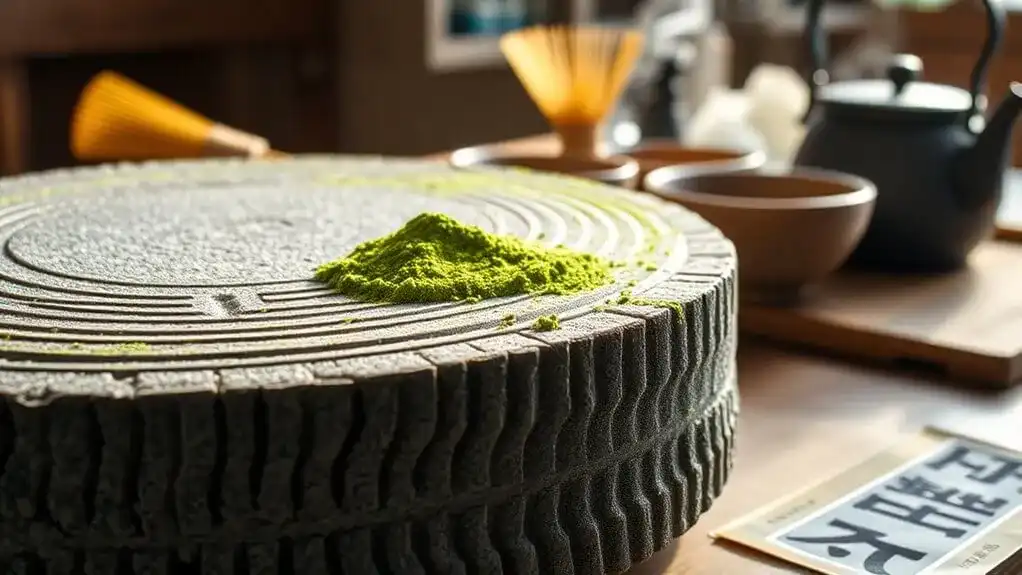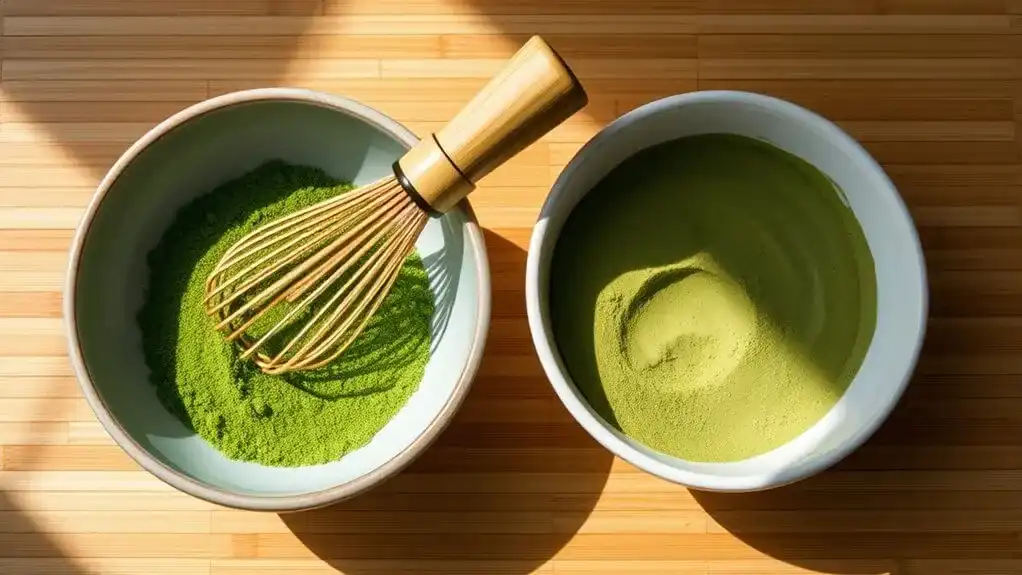Traditional stone grinding of matcha using granite mills preserves the tea's essential nutrients and delicate flavor profile in ways machine processing can't match. The slow, precise rotation at 30 RPM prevents heat damage while maximizing the powder's beneficial compounds, resulting in up to 10 times more antioxidants than regular green tea. This time-honored technique, rooted in 12th-century Japanese culture, represents the intersection of artisanal craftsmanship and scientific precision – a journey that reveals matcha's true excellence.
Key Points
- Traditional granite mills rotate slowly at 30 RPM, preventing heat damage and preserving essential nutrients unlike machine grinders.
- Stone grinding produces only 30-40 grams per hour, prioritizing quality over quantity for superior matcha characteristics.
- The careful stone-grinding process maintains beneficial compounds and antioxidants, resulting in up to 10 times more nutrients than regular tea.
- Traditional processing respects environmental sustainability while maximizing the tea's biochemical advantages through controlled grinding temperatures.
- Stone-ground matcha upholds centuries-old Japanese craftsmanship, ensuring authentic flavor profiles and cultural integrity in the final product.
The Ancient Art of Stone Grinding
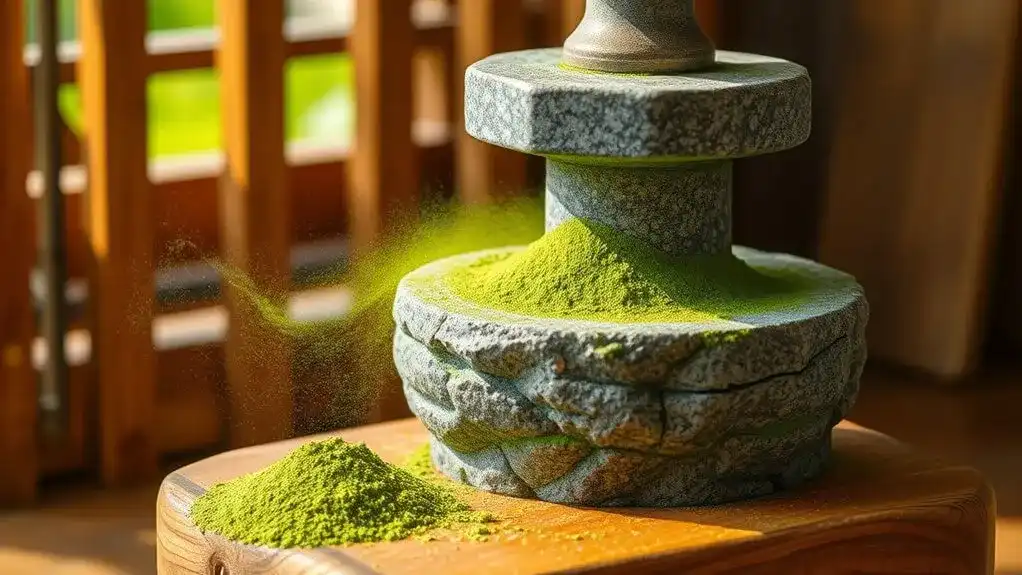
Three distinct aspects define the ancient art of stone grinding matcha: the traditional granite mill, precise grinding speed, and superior quality results. The process, introduced by Zen Buddhist monk Esai in 12th century Japan, relies on the ishi-usu stone mill's soft granite composition to prevent excessive friction and heat.
The grinding techniques employed are remarkably precise, with the mill rotating counterclockwise at thirty revolutions per minute. This methodical approach yields just 30g of matcha powder per hour, but the slow speed preserves essential nutrients and creates an unparalleled product. Machine grinders can damage the tea through excess heat generation, compromising the natural aroma. This time-honored technique emphasizes artisanal craftsmanship in every step of production. When prepared properly, the powder requires vigorous whisking to achieve its signature frothy texture. While modern methods prioritize efficiency, traditional stone mill processing guarantees superior results: vibrant green color, smooth texture, and maximum antioxidant retention. The end product creates a creamy, frothy matcha that exemplifies why this ancient art continues to be the gold standard.
Preserving Nature's Delicate Balance
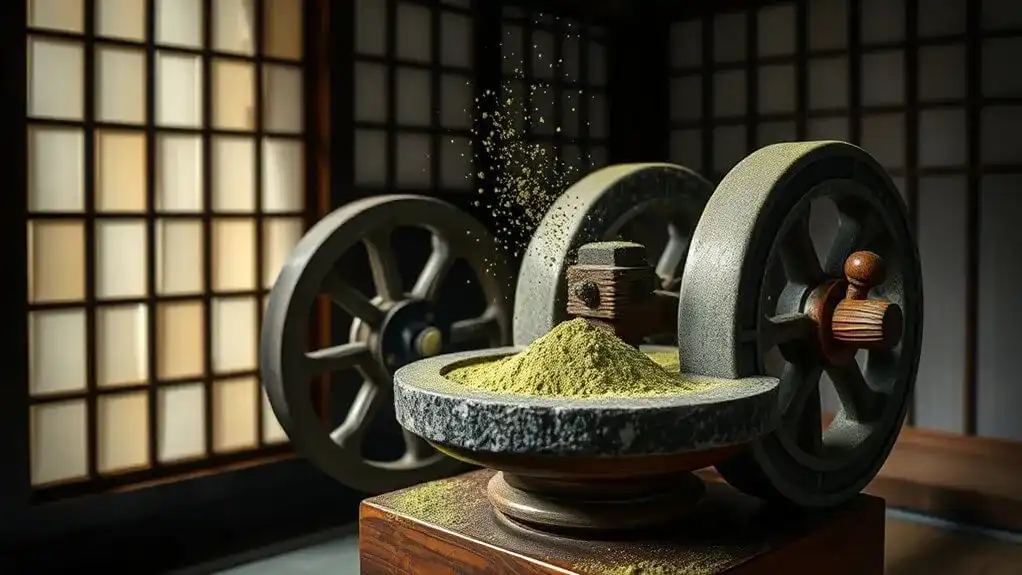
While matcha production has evolved over centuries, its environmental impact remains remarkably gentle on nature's delicate balance. The traditional cultivation methods, particularly when organic and pesticide-free, maintain the ecological balance while producing high-quality tea. Shading techniques enhance the tea's beneficial compounds without disrupting the surrounding ecosystem. The use of traditional whisking methods creates the perfect frothy texture without requiring electricity or machines. The tea plants' longevity contributes significantly to sustainable agriculture, as these bushes can continue producing leaves for over five decades. Similar to how the handbook emphasizes ethical research practices, today's matcha producers prioritize responsible sourcing and documentation of their cultivation methods.
What makes matcha particularly sustainable is its waste-reducing approach of using the entire tea leaf. Today's producers who follow sustainable practices often embrace crop rotation and fair trade principles, ensuring both environmental and social responsibility. While transportation does create some carbon footprint, matcha's concentrated powder form makes it efficient to ship. Consumers can further support this ecological balance by choosing organic, certified matcha from local sources and using traditional reusable utensils instead of disposable alternatives.
From Garden to Granite: The Journey of Quality
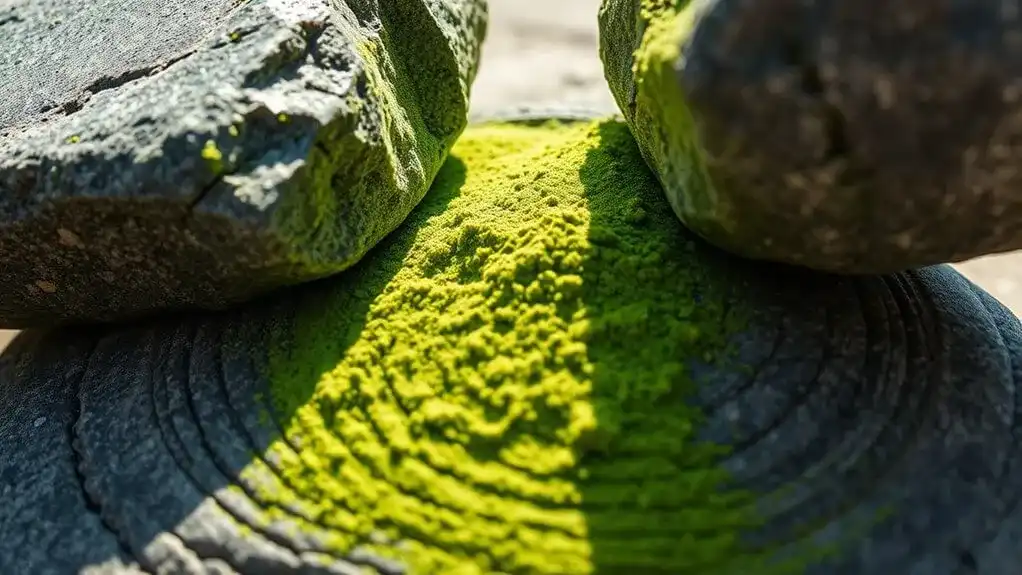
When premium matcha reaches a stone mill, it represents countless hours of meticulous cultivation and preparation. The journey begins with specialized harvest techniques, including three weeks of shading to boost chlorophyll and antioxidants. Hand-picked leaves undergo immediate steaming and cooling to lock in their vibrant qualities. Camellia sinensis tea plants are carefully selected for their superior flavor characteristics before cultivation even begins. The transformation continues as workers carefully remove stems and veins, preparing the leaves for their evolution into tencha. The leaves are gently steamed to preserve their rich nutritional content and prevent oxidation. Through precise air and heat drying, the leaves develop distinct flavor profiles that will define the final product. It's a process of remarkable reduction – only about 10% of the original harvest makes it to the grinding stage. Each stone mill produces just 30 to 40 grams of matcha powder per hour in carefully monitored conditions. This intensive preparation guarantees that when the leaves meet the granite stones, they're perfectly primed to become exceptional matcha powder.
The Science Behind Traditional Processing
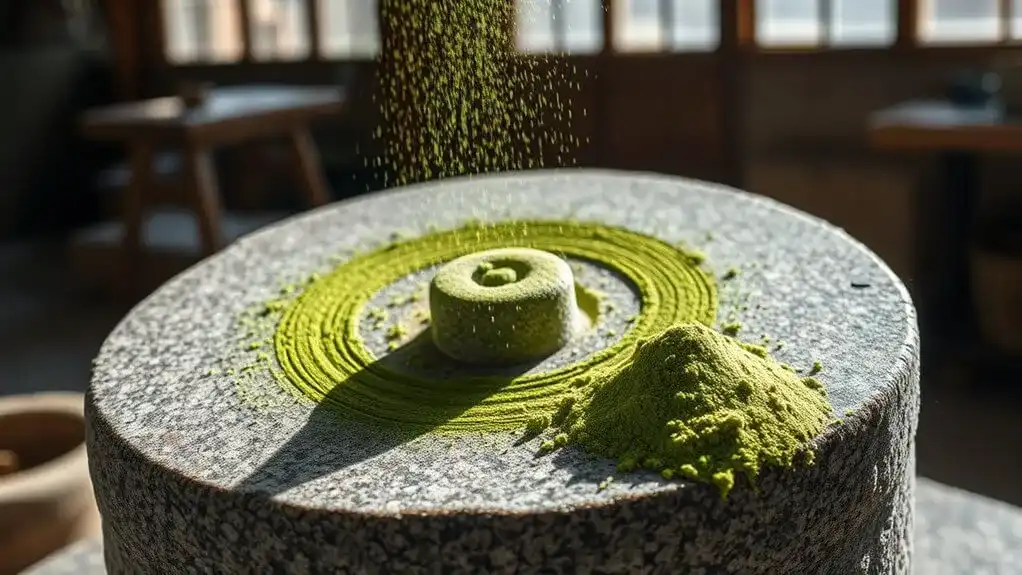
The scientific principles behind traditional matcha processing reveal a sophisticated understanding of plant biochemistry. When farmers employ shading techniques with bamboo mats, they're triggering essential metabolic changes in the tea leaves. This reduced sunlight exposure prompts the plants to produce more chlorophyll and L-theanine, creating matcha's distinctive umami flavor and vibrant green color. Similar to the three-year statute that governs tax adjustments, quality control standards for matcha must be consistently monitored within specific timeframes.
The steaming benefits extend beyond mere preservation. This vital step halts enzymatic activity that would otherwise degrade the leaves' quality, effectively "locking in" the enhanced nutrients and flavors developed during shading. The careful removal of stems and veins, followed by precise stone grinding at controlled temperatures, guarantees these biochemical advantages aren't compromised. High-capacity grinding machines are now used alongside traditional methods to maintain quality while meeting increased demand. Each step works in harmony to maintain the delicate balance of compounds that make matcha unique. The tencha drying process on bamboo mats ensures optimal moisture reduction while preserving the tea's delicate flavors.
Time-Honored Techniques in Modern Times
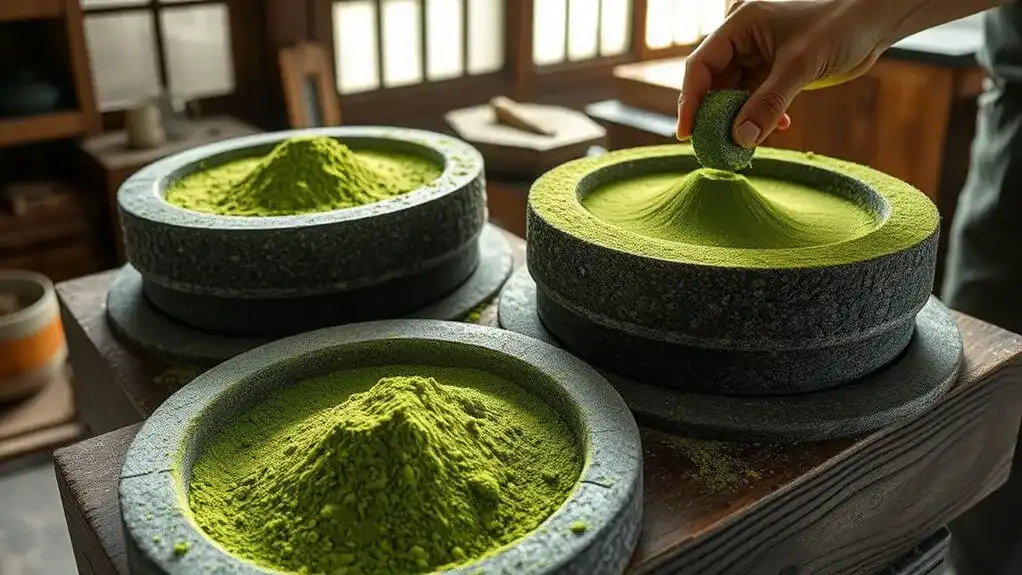
Modern matcha production artfully balances age-old wisdom with contemporary innovation. While some farms have adopted mechanized processes, many still honor traditional bamboo shading techniques to enhance the tea's quality. These carefully placed bamboo mats reduce sunlight exposure, naturally boosting chlorophyll and amino acid levels in the leaves. Cooling and drying is crucial for preserving the delicate leaf structure after the initial steaming process.
Hand harvesting methods remain a cornerstone of premium matcha production, with skilled workers selecting only the finest tea buds. Though larger operations incorporate machinery for efficiency, they maintain strict quality standards throughout the process. Organic certified farms must undergo regular inspections to maintain their status. The fusion of old and new extends to processing, where high-precision machines complement traditional stone grinding. This careful blend of techniques guarantees that today's matcha production preserves its cultural heritage while meeting modern demands for both quality and quantity. A conscientious approach to processing has been shown to predict better product outcomes and success in the tea industry.
Health Benefits of Stone-Ground Matcha
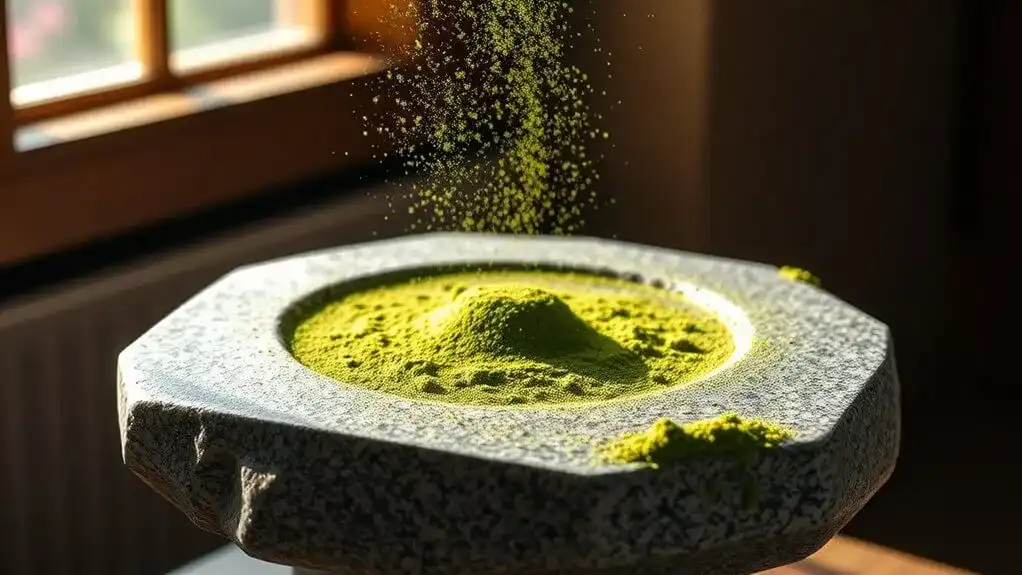
Stone-ground matcha stands out as one of nature's most potent superfoods, delivering an impressive array of health benefits through its concentrated antioxidant properties. The traditional stone-grinding process preserves matcha's essential compounds, particularly its catechins and EGCG, which are vital for fighting oxidative stress and inflammation. Studies show matcha contains up to 10 times more antioxidants than regular green tea. Buddhist monks historically consumed matcha for its calming and energizing effects. The combination of L-theanine and caffeine promotes cognitive enhancement while maintaining mental clarity.
The health benefits of stone-ground matcha manifest in several key ways:
- Cardiovascular Support: It improves cholesterol levels, regulates blood pressure, and prevents arterial plaque formation
- Metabolic Enhancement: It boosts metabolism, supports fat oxidation, and aids in weight management
- Immune Protection: It strengthens the body's defense systems through its powerful antioxidant properties
These benefits stem from matcha's unique processing method, which maintains the tea's nutritional integrity and guarantees maximum bioavailability of its beneficial compounds.
Cultural Legacy and Global Impact

Beyond its remarkable health properties, matcha tea carries a rich cultural heritage that spans centuries of Japanese history and continues to influence global culinary practices today. Since its introduction by Zen Buddhist monks in the 12th century, matcha has evolved from a ceremonial drink to a worldwide phenomenon, fostering cultural exchange between Japan and other nations. Tea preparation involves sifting the powder to achieve the smoothest possible consistency.
The traditional tea ceremony, with its emphasis on harmony, respect, and mindfulness, has garnered global appreciation for its artistic and performative elements. The meticulous process of cleaning tea utensils remains an essential component of preserving authenticity in modern ceremonies. The tea is carefully prepared in rooms adorned with tatami mats and often accompanied by traditional sweets. Modern culinary innovators have embraced matcha's versatility, incorporating it into diverse products from ice cream to baked goods. Despite this contemporary evolution, matcha's cultural significance remains deeply rooted in Japanese tradition, where it's still revered as a cultural treasure and continues to embody the principles of Zen Buddhism through precisely choreographed preparation techniques.
Conclusion
Like jade rivers carving ancient stones, traditional matcha processing carries wisdom through time. Today's stone-ground matcha stands as a living bridge between past and present, where each granite revolution preserves tea's sacred essence. As modern tea lovers embrace this emerald elixir, they're not just drinking tea – they're participating in a timeless ritual that honors both nature's bounty and humanity's patient dedication to perfection.
